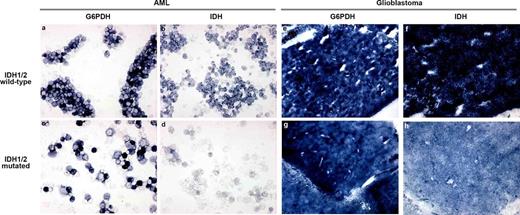Abstract
Background: Mutations in isocitrate dehydrogenase 1 and 2 (IDH1/2MT) occur in up to 20% of MDS, MDS/MPN overlap and (s)AML. These mutations induce a metabolic rewiring of cancer cells that may impose metabolic vulnerabilities which can be pharmacologically targeted. In carcinoma cells, IDH1MT sensitize cells to oxidative stress induced by irradiation and treatment with electron transport chain complex I inhibitors, such as phenformin and metformin. Conversely, IDH1MT inhibitors protect IDH1MT cells against these treatment modalities. As a consequence, IDH1MT inhibitors and cytotoxic drugs should not be used together in patients with IDH1MT carcinoma and this has clinical relevance since IDH1/2MT inhibitors are already in phase I clinical trials. The underlying mechanism is that IDH1MT dramatically reduce the cellular production capacity of NADPH, an important antioxidant, and IDH1MT inhibitors restore the NADPH production capacity. Of note, IDH1 and IDH2 are the most important providers of NADPH in most cells.
Methods: Primary IDH1/2MT, IDH1/2WT and TET2MT AML cells (n=15) were cultured and treated with the IDH1MT inhibitor AGI-5198, the IDH2MT inhibitor AGI-6780, irradiation, phenformin, metformin, daunorubicin or cytarabine. Cell numbers were counted 5 days after therapy exposure. In addition, cells were adhered to microscopy slides and maximal IDH1/2 and G6PD activity was determined using quantitative enzyme cytochemistry. ROS levels were fluorometrically measured using flow cytometry.
Results: We observed that IDH1/2MT do not sensitize primary AML cells to irradiation, phenformin, metformin, daunorubicin or cytarabine and IDH1/2MT inhibitors had no effect on therapy sensitivity in primary AML cells. Because it is argued that inactivating TET2MT function downstream of IDH1/2MT, TET2MT AML cells served as a negative control and showed no sensitization neither.Although IDH1/2MT greatly reduce the IDH1/2-mediated NADPH production capacity in AML cells (P < 0.0001), IDH1/2 are not important NADPH providers in myeloid cells and the contribution of glucose-6-phosphate dehydrogenase (G6PD) to the total NADPH production pool is much larger (maximal G6PD activity is ~4 times higher than maximal IDH1/2 activity, Fig. 1). This contrasts the situation in glioblastoma, where IDH1/2 provide 65% of all NADPH. Large-scale mRNA-sequencing in AML and glio(blasto)ma datasets revealed no differences in IDH1/2 and G6PD expression between types of cancer, suggesting that post-translational modifications perform key roles in regulating the maximal activity of these enzymes (Fig. 2). To investigate the implications of these results on cellular redox potentials, we performed ROS measurements after treatment with irradiation and observed that IDH1/2MT do not increase ROS in AML cells, whereas IDH1/2MT do increase ROS in glioma cells.
Discussion: Increased sensitivity to oxidative stress is not a metabolic vulnerability in IDH1/2MT AML and this is likely due to the fact that maximal NADPH production capacity is affected to only a small extent in IDH1/2MT AML. Therapies that increase oxidative stress, such as irradiation and metformin, counteract with IDH1/2MT inhibitors in glio(blasto)ma cells because there, IDH1/2MT have profound implications on cellular NADPH production capacities and ROS levels. Our results suggest that IDH1/2MT do not induce sensitivity to cytotoxic drugs in AML cells and thatIDH1/2MT inhibitors can be safely used adjuvantly to the AML standard of care daunorubicin and cytarabine, or whole-body irradiation in the context of bone marrow transplantations. These data are crucial for phase II and III clinical trial designs ofIDH1/2MT inhibitors.
G6PD (a, c, e, g) and IDH1 activity (b, d, f, h) staining of IDH1R132 non-mutated (a, b, e, f) and mutated (c, d, g, h) primary AML cells (a-d) and glioblastoma (e-h) cryostat sections. The amount of blue color (nitro BT-formazan) directly reflects IDH1/2 and G6PD activity (production of NADPH).
IDH1MT reduce maximal IDH1/2 activity, but IDH1/2 is a more important NADPH producer in glioblastoma than in AML compared with G6PD.
IDH1MT reduce maximal IDH1/2 activity, but IDH1/2 is a more important NADPH producer in glioblastoma than in AML compared with G6PD.
mRNA sequencing reveals no differences in IDH1, IDH2 and G6PD expression between AML, low-grade glioma (LGG) and glioblastoma (GBM).
mRNA sequencing reveals no differences in IDH1, IDH2 and G6PD expression between AML, low-grade glioma (LGG) and glioblastoma (GBM).
No relevant conflicts of interest to declare.
Author notes
Asterisk with author names denotes non-ASH members.



